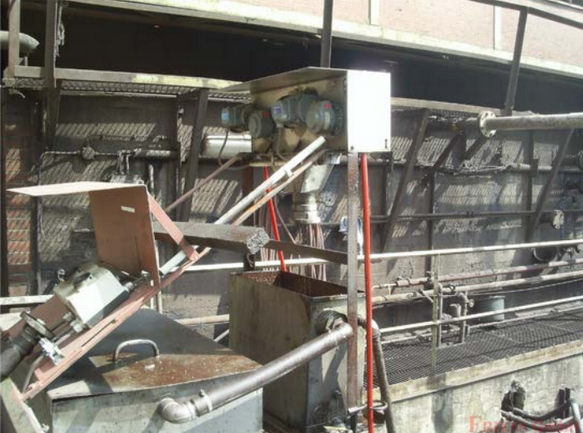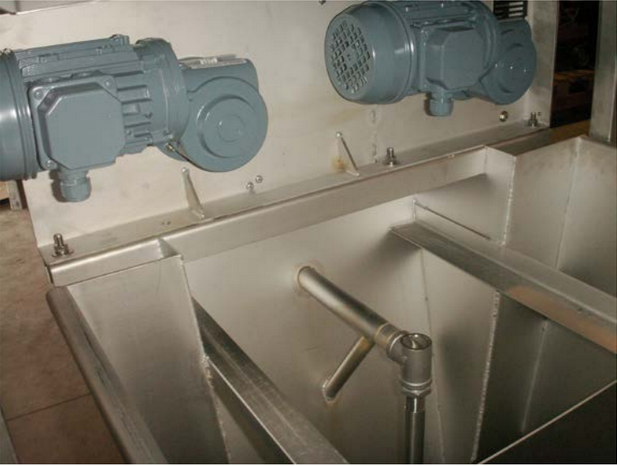FRIESS Oil Skimmer in the steel industry
In order to clean the cooling water in steel factories companies usually use a combination of scale pit, longitudinal clarifier and gravel filter.
Scale pit in the steel industry

Compared to water the specific weight of scale is much higher. For this reason the scale particles will settle on the bottom of the scale pit and the longitudinal clarifier. The scale, collected on the bottom of the scale pit, will be removed by an excavator. The scale, which settles on the bottom of the longitudinal clarifier, will be collected in the deep part of the basin with the help of a scraper. From time to time the collected scale will be removed by an excavator.
Longitudinal clarifier with scraper in a steel factory
The specific weight of oil and grease is lower than the specific weight of water. For this reason oil and grease will settle on the surface of the water. The most part of the oil will settle on the longitudinal clarifier. The flow of the water in the longitudinal clarifier will drive the floating oil and fat to the outlet of the basin. The floating oil and grease will be stopped by a downflow baffle. The water floats underneath the downflow baffle into the pump chamber. From there the water will be pumped into the gravel filter and back into the factory. On the water surface in the longitudinal clarifier grease, lubrication oil, hydraulic oil and other hydrocarbons mixed with scale and particles, float on the water. It is extremely necessary to remove the floating hydrocarbons. Otherwise oil and grease will accumulate in the gravel filter and finally will block the gravel filter.
The easiest way to remove the floating oil and grease is an adjustable channel.

Adjustable channel in a longitudinal clarifier
The inlet edge of the channel must have the same height as the water surface. Continuously water with oil will flow into the channel and is removed out of the cooling water separation. The big disadvantage of this method is that the adjustable channel will remove typically 1 % – 2 % of oil mixed with 98 % – 99 % water. The mixture of oil and water has to be separated in an additional decanter. In order to remove the floating oil and grease easily and efficient we recommend to use the oil skimmer model S 100 with oil collector tube and small decanter.
Adjustable channel in a longitudinal clarifier

The inlet edge of the channel must have the same height as the water surface. Continuously water with oil will flow into the channel and is removed out of the cooling water separation. The big disadvantage of this method is that the adjustable channel will remove typically 1 % – 2 % of oil mixed with 98 % – 99 % water. The mixture of oil and water has to be separated in an additional decanter. In order to remove the floating oil and grease easily and efficient we recommend to use the oil skimmer model S 100 with oil collector tube and small decanter tank.
Oil skimmer S 100 at longitudinal clarifier

The oil skimmer will be mounted at the end of the longitudinal clarifier near the pump chamber. The oil collector tube floats on the water and will be guided parallel to the downflow baffle. The oil collector tube works along the whole width of the basin. The oil and grease, which has been picked up by the oil collector tube, floats from the scraper in the oil skimmer into sludge trap underneath the oil skimmer.
Oil collector tube with tube guide and Oil collector tube floats parallel to downflow

Sludge trap under oil skimmer model S 100

In the sludge trap bigger particles like cigarettes, styrofoam chips or leaves will be collected. The oil floats through the big pores of the sludge trap into the oil collecting tank. Underneath the sludge trap the oil collecting tank has a decanter in order to separate some water, which has been collected together with the oil. The water mixed with the oil will settle on the bottom of the decanter tank. The specific weight of the oil is lower and the oil will float on the top. The floating oil will flow over a baffle into the next chamber of the tank.
Water return pipe inside the decanter tank

At the same time some water will flow through a pipe from the bottom of the tank to the top and will flow through the pipe back into the longitudinal clarifier. This system makes sure, that the oil, that has been collected, contains only small amounts of water. In order to avoid frost damage at temperatures below 0 °C the tank can be equipped with additional heating. From time to time the collected oil will be pumped by an excentric screw pump into the waste oil collecting tank. The excentric screw pumps are extremely robust and able to pump hydrocarbons with high viscosity.
Working principle of decanter tank

result
The continuous removal of the floating oil and grease from the surface of the longitudinal clarifier avoids that small droplets of hydrocarbons will be driven by the flow of water from the surface along the downflow baffle into the pump chamber and the gravel filter. Correct design of the system and continuous removal of oil will provide the cooling water with an oil content of less than 5 mg/l.
